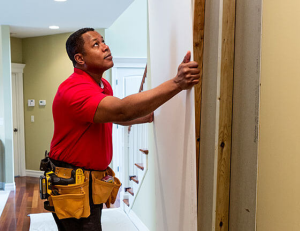A Handyman is a jack of all trades that can handle a variety of home repairs and projects. They don’t require a license or specific education, but they must be able to complete the work that customers hire them for.
Handymen can help refresh old light fixtures and improve air flow by mounting ceiling fans. They can also install drywall and repair water damage. They may even be able to clean gutters and roofs. Click https://www.handymannapervilleil.com/ to learn more.

A fish tape is a flexible, yet sturdy metal wire that helps to guide electrical wires and cables through walls and ceilings. It is a popular tool in the trade and can be used for a wide variety of projects. It is important to know how to use this tool properly to avoid damaging the wiring and other items in your home or commercial building.
There are many different types of fish tapes available, each designed for a specific application. Some are rated for conduit, while others are ideal for running cable in walls and ceilings. There are also non-conductive fiberglass versions that are safer to use in existing buildings. In addition to being safer, they are also more durable.
When choosing a fish tape, it is important to consider its length and tensile strength. A longer tape is more flexible and easier to navigate curves, while a thicker one has better push and pull strength. Most fish tapes are a combination of steel and fiberglass, with a steel-wire leader to help navigate bends. They are usually housed in a donut-shaped case, which allows users to extend and retract the tape with a handle.
If you are using a metal fish tape, make sure to turn off the electricity before you begin working. The metal wire is a conductor of electricity, and it can cause electrocution if you are not careful. It is also important to wear safety glasses when you are working with this tool. It is also a good idea to keep the fish tape casing sealed up, except when you need to replace it.
Some fish tapes have a loop at the end that is useful for hooking onto existing wiring. This can save you time and effort when running wires, especially if you are stuck on a blockage that you cannot get around.
Another option is an electric fish tape, which can feed and retract lines up to two times faster than manual models. They are a great choice for professionals who work with large amounts of cable on a regular basis. They can also reduce the amount of physical strain on your hands and back. Some models come with ergonomic designs, such as overmolded handles and grip ridges, that are stronger and more slip-resistant than traditional plastic handles.
Electrical tape
Electrical tape is an essential tool for a handyman, as it can help them perform many different jobs. Its main function is to insulate wires, but it can also be used to protect them from dirt and moisture. In addition, it can help prevent accidental shocks and short circuits. This is particularly important when working with live wires, and it can also reduce the risk of fire hazards. It is important to choose a premium quality electrical tape that is designed to withstand a variety of environments.
It is important to use the right technique when applying electrical tape. It should be applied with a half-lap, which creates a stronger binding and enhanced insulation. It is also best to stretch the tape as you wrap it, as this will allow it to conform better to surfaces and resist damage. You should also leave a 1/2 inch of tape at the end to make it easier to cut with scissors.
The adhesive on electrical tape is very strong, and it can withstand high temperatures. It is also resistant to abrasion and moisture, making it an ideal choice for many environments. In addition, it is easy to remove and does not leave a sticky residue. This makes it a great choice for a number of different tasks, including general quick fixes around the house.
In addition to being an excellent insulator, electrical tape can be used to mark or label wires. It is available in a range of colors, each representing a specific voltage level or usage designation. This makes it easy to identify which wires are carrying a higher voltage or require attention before touching.
Handymen should always make sure that the work area is free of electricity before applying electrical tape. This can be done by turning off the power at the breaker box and double-checking it with a tester. Many accidents happen when people attempt to bind or insulate wires while the power is still on. Duct tape can be used as a temporary fix, but it lacks the flexibility and insulating properties of electrical tape.
Circular saw
A circular saw is a versatile power tool that can be used by a handyman for many projects. It can cut a variety of materials, including wood and metal. However, using this tool requires careful attention and safety precautions. A handyman should always wear a mask and protective eyewear when working with a circular saw. Also, he or she should make sure the blade is not too deep into the material being cut. This can cause a lot of friction, which can damage the saw and the material being cut. If possible, a handyman should use a sturdy work table or sawhorses when cutting wood or other materials.
The type of project a handyman plans to do will help determine the right kind of circular saw to buy. When selecting a saw, consider the saw style and size, torque, weight, and other features. For example, you should consider whether you need a left- or right-blade model and if you want a corded or cordless saw. A cordless saw may be a better choice for a DIYer who needs to make multiple cuts.
Another important feature to consider when buying a circular saw is its RPM speed. This measurement relates to how quickly the motor can spin the blade, which is critical for making cuts efficiently. If the blade is too slow, it can result in dull blades and poor cuts. You should also look for a blade designed to cut the material you are working with.
Once you have chosen a circular saw, practice on some scrap wood to get a feel for how it performs. You should also check for the safety features of the saw, including its blade guard and brake. A good quality circular saw should have a blade guard that is easily adjustable and a work light that illuminates the area where you are cutting.
A circular saw can be used to make a variety of different cuts in various materials, including wood, metal, and plastic. It can be used to create rip or cross cuts, and it is often useful for making straight cuts. It can also be used to cut sheet materials such as plywood or Medium Density Fibreboard (MDF). When purchasing a saw, it is important to choose one that has a dust extract nozzle to minimize the amount of debris created when cutting these materials.
Hammer
A hammer is a hand tool consisting of a weighted head fixed to a long handle that can be swung to deliver an impact force to a small area of an object. It is used for a variety of driving, shaping, and breaking applications, including carpentry, blacksmithing, warfare, and percussive musicianship. Hammers are often constructed from metal, but can also be made of wood, glass, or stone. Hammers can be manual or powered, and their designs have been modified to achieve optimum utility in many different circumstances.
The shape and size of a hammer head are important considerations when selecting the right one for a particular job. A rounded head will have more power for driving in nails, while a flat or square-shaped head is better suited for prying, splitting wood, or tearing drywall. The size of the handle is also a factor, as the user’s position must be taken into account when using the hammer. Longer handles will increase the amount of energy delivered to the target, but may be difficult to maneuver in tight spaces.
Hammers are also used in industrial settings such as mines, petroleum refineries, and chemical plants. They are available in non-sparking varieties, which are especially useful in flammable or explosive environments. These hammers are typically made from aluminum or beryllium copper, and their heads are made of a material that will not spark when struck against other materials. They are usually lighter than sledge hammers and have a smaller head.
Hammers can be dangerous, both for the person who uses them and those around them. They can cause damage to structures if used improperly, and they can create shock waves that injure nerves or the skeleton. They can also cause RSI or other hand injuries if the handles are too large or awkward to hold. They can also produce small metallic projectiles that can get lodged in the eye. For these reasons, it is essential to wear safety glasses when working with a hammer.
